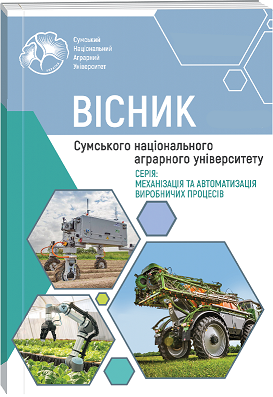PROSPECTIVE USE OF FUNCTIONAL INGREDIENTS BASED ON CULTIVATED MUSHROOM RAW MATERIAL IN SNACKS TECHNOLOGY
Abstract
The article analyzes the prospects for the use of cultivated mushroom raw materials (CMRM) in the technology of snack products. The significant consumer appeal and timeliness of the development of snacks as products for quick hunger relief, as well as those with functional properties, have been established. The special importance of this product was revealed in the period of frequent stresses caused by military actions, when the body needs an extraordinary amount of energy and related substances in order to maximize adaptation and overcome crisis states of the body. Attention is focused on the fact that the way of enriching traditional food products with biologically active components, which are lacking in the diet of the population, is currently the most real, fast, economically beneficial and technologically available. It was determined that innovations in the technology of snack products make it possible to preserve the useful properties of the product and make it tastier. Such solutions can contribute to increasing the shelf life of finished products, in particular due to the introduction of natural antioxidants. Attention is drawn to increasing the nutritional value of snack products in two ways: by including natural food ingredients in the recipe and by enriching with missing substances. The effect of champignon powder on the organoleptic, functional and technological properties of snack products is considered. A technological scheme of new products has been developed. The indicators of its nutritional value have been determined. The article substantiates the prospect of saturation of screw products with missing functional ingredients and improvement of consumer properties. The conducted studies proved the expediency of using CMRM in the amount of 15% in order to obtain a product with high organoleptic, permissible physico-chemical indicators. Recommendations for the use of the developed products in therapeutic and preventive nutrition due to the content of functional ingredients in their composition are outlined.
References
2. Basu, S.K. Thomas, J.E. & Acharya S.N. (2007). Prospects for Growth in Global Nutraceutical and Functional Food Markets: A Canadian Perspective. Australian Journal of Basic and Applied Sciences, 1(4).
3. Chen S, Oh S.R., Phung S., Hur G., Ye J.J. & Kwok S.L. (2006). Anti-aromatase activity of phytochemicals in white button mushrooms (Agaricus bisporus). Cancer Res, 66. doi: 10.1158/0008-5472.CAN-06-220
4. DSTU 4910:2008 Vyroby kondyterski. Metody vyznachennia masovykh chastok volohy ta sukhykh rechovyn. [Confectionery products. Methods of determination of moisture and dried matter content]. Kyiv: DerzhStandart Ukrainy, 12 p. (in Ukrainian).
5. DSTU 5024:2008 Vyroby kondyterski. Metody vyznachannia kyslotnosti ta luzhnosti. [Confectionery products. Methods of determination acidity and alkalinity]. Kyiv: DerzhStandart Ukrainy, 10 p. (in Ukrainian).
6. Haijuan N., Bo L., Stepanova T. & Kondratjuk T. (2022). Modern achievement of food science in aspects of cultivated mushrooms application in food technology. Oldi+, 110 p.
7. Hladkyi, F. (2018). Sensornyi analiz kharchovykh produktiv [Sensory analysis of food products]. Kharkiv: Tekhnolohichnyi tsentr, 131 p.
8. Jeong S.C., Jeong Y.T., Yang B.K., Islam R., Koyyalamudi S.R. & Pang G. (2010). White button mushroom (Agaricus bisporus) lowers blood glucose and cholesterol levels in diabetic and hypercholesterolemic rats. Nutr Res, 30, pp.49-56. doi: 10.1016/j.nutres.2009.12.003
9. Kawakami S., Araki T., Ohba K., Sasaki K., Kamada T. & Shimada K. (2016). Comparison of the effect of two types of whole mushroom (Agaricus bisporus) powders on intestinal fermentation in rats. Biosci Biotechnol Biochem, 80, pp. 2001-2006. doi: 10.1080/09168451.2016.1196573.
10. Komura D.L., Carbonero E.R., Gracher A.H., Baggio C.H., Freitas C.S. & Marcon R. (2010). Structure of Agaricus Spp. Fucogalactans and their anti-inflammatory and antinociceptive properties. Bioresour Technol, 101, pp. 6192-6199. doi: 10.1016/j.biortech.2010.01.142
11. Kozarski M., Klaus A., Niksic M., Jakovljevic D., Helsper, J., Griensven L. (2011). Antioxidative and immunomodulating activities of polysaccharide extracts of the medicinal mushrooms Agaricus bisporus, Agaricus brasiliensis, Ganoderma lucidum and Phellinus linteus. Food Chemistry, 129(4), pp. 1667-1675. doi: 10.1016/j.foodchem.2011.06.029
12. Mattila, P. (2000). Functional Properties of Edible Mushrooms, Nutrition, 16. doi: 10.1016/s0899-9007(00)00341-5
13. Moro C., Palacios I. & Lozano M. (2012). Anti-inflammatory activity of methanolic extracts from edible mushrooms in LPS activated RAW 264.7 macrophages. Food Chem, 130, pp. 350-355. doi: 10.1016/j.foodchem.2011.07.049
14. Owaid, M.N., Barish, A. & Ali Shariati, M. (2017). Cultivation of Agaricus bisporus (button mushroom) and its usages in the biosynthesis of nanoparticles, Open Agriculture, 2 (1), doi:10.1515/opag-2017-0056
15. Ramadan, I. (2020). Functional Foods and their impact in attracting Customers to Egyptian Hospitality firms. Journal of Association of Arab Universities for Tourism and Hospitality. 18(2). doi: 10.21608/JAAUTH.2020.32469.1033
16. Ren Z., Guo Z., Meydani S.N. & Wu D. (2008). White button mushroom enhances maturation of bone marrow-derived dendritic cells and their antigen presenting function in mice. J Nutr, 138, doi: 10.1093/jn/138.3.544
17. Shemeta, О.О. & Dozhuk, К.М. Funktsionalne kharchuvannia – novyi pidkhid do zdorovoho sposobu zhyttia [Functional nutrition is a new approach to a healthy lifestyle] Liky Ukrainy, 1(86), pp. 24-27. (in Ukrainian).
18. Wani, B.A. (2010). Nutritional and medicinal importance of mushrooms. Journal of medicinal plant research. 4(24). doi:10/5897/JMPR09.565
19. Zheng R, Jie S, Hanchuan D, Moucheng W. (2005). Characterization and immunomodulating activities of polysaccharide from Lentinus edodes. Int Immunopharmacol, 5, pp. 811-820. doi: 10.1016/j.intimp.2004.11.011
20. Zięba, P., Sękara A., Sułkowska-Ziaja K. & Muszyńska B. (2020). Culinary and Medicinal Mushrooms: Insight into Growing Technologies. Acta Mycologica, 55(2), doi: 10.5586/am.5526
21. Zubar, N. (2010). Osnovy fiziolohii ta hihiieny kharchuvannia [Basics of physiology and food hygiene]. Kyiv: Tsentr uchbovoi literatury, 336 p. (in Ukrainian).

 ISSN
ISSN  ISSN
ISSN 



